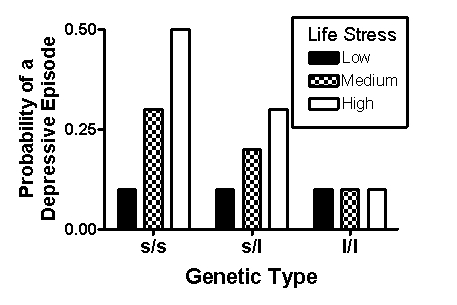Scenario I
The following scenario is based on and presents fabricated data consistent with the following study:
Caspi, A., Sugden, K., Moffitt, T. E., Taylor, A., Craig, I. W., Harrington, H., McClay, J., Mill, J., Martin, J., Braithwaite, A., and Poulton, R. (2003) . Influence of life stress on depression: Moderation by a polymorphism in the 5-HTT gene. Science, 301(5631) , 386-389.
The serotonin transporter gene codes for the serotonin transporter, a protein that transports serotonin from the synapse to the presynaptic neuron. Several polymorphisms of the gene exist, including a "short" (s) and a "long" (l) variation. As humans receive one copy of the gene from each parent, people can be grouped into three groups based on this genetic variation: s/s (two copies of the short gene) , s/l, and l/l. Caspi et al. (2003) interviewed participants in each of these groups and asked them a wide range of questions to determine both the degree of exposure to stress and the number of depressive episodes participants had experienced in their lives. Fabricated results consistent with their major findings are shown in Figure 3.1.
Figure 3.1 
-(Scenario I) Which statement is NOT true about the relationship between genetic variation and depression under conditions of high stress?
Definitions:
Aspirations
Desires or ambitions of achieving something, typically referring to goals related to personal or professional success.
Freud and Adler
Sigmund Freud and Alfred Adler, influential figures in psychology, known for their contributions to psychoanalytic theory and individual psychology, respectively.
Relationship Change
The dynamic modification or transformation of interpersonal relationships over time due to various factors such as personal growth, external circumstances, or conflicts.
First-born Children
Children born first in their family, who often exhibit specific personality traits and developmental influences due to their birth order.
Q5: The activation of mirror neurons is vital
Q7: A split-brain patient can verbalize a description
Q8: (Scenario II) Using the procedure described in
Q8: (Scenario II) Shown in Figure 6.2 is
Q38: A random sample means that every participant
Q72: The _, or "little man," is a
Q162: Which brain structure is NOT part of
Q174: Sound-wave frequency is to pitch as amplitude
Q221: John does not enjoy his food as
Q246: Stimuli that are presented at the absolute